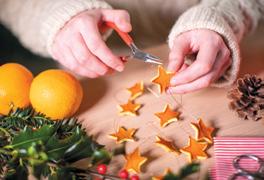
4 minute read
SUSTAINABLE HOLIDAYS
EASY TIPS FOR AN ECO-FRIENDLY SEASON
by Kirby Baldwin
Advertisement
sewcream/AdobeStock.com T he holidays are upon us, and that means decking the halls, gathering with loved ones, exchanging gifts and treats—and creating a lot of waste in the process. From Thanksgiving to New Year’s Day, Americans throw away 25 percent more trash than at any other time of year. That’s 1 million extra tons each week, primarily due to waste from holiday gifts and décor. Fortunately, there are ways to cut down on consumption to lessen the environmental impact of the holiday season without sacrificing any joy.

Savor Local Fare
Ditch grocery store lines and instead shop for the holiday meal at a nearby family farm. By participating in the local food movement, we will not only enjoy fresh, seasonal ingredients while supporting the local economy, but also sustain farms that build soil health, promote animal well-being and offer a more delicious and nutritionally superior final product. Purchasing food directly from farmers also eliminates the extra packaging and the carbon footprint of transportation that comes with store-bought goods.
In addition to offering fruits and vegetables for holiday pies and soufflés, regional farms can also be good sources for locally sourced grains, holiday meats, baked goods and cheeses. Festive cocktails can be purchased from a neighborhood distillery, brewery or winery, many of which source their ingredients from local farmers.
Ronald Mirante, founder of Bone-In Food, runs a weekly food delivery service that provides only sustainable, nutrientdense foods sourced from local farm
partners. According to Mirante, “Shopping for food locally with your farmers for the holiday helps them move offerings they have raised all season long. This empowers the local food community and makes their operations sustainable by preventing food waste and allowing for economic preparation for next year’s harvest.”
For a state-by-state directory of local farmers of meat, eggs and dairy products from 100 percent pastured animals, visit EatWild. com. A directory of family farms and farmers markets, along with restaurants and grocery stores that feature locally produced food, can be found at LocalHarvest.org.
Gift Greener

Katecat/AdobeStock.com
Instead of using unrecyclable gift wrapping paper, switch to a recycled alternative or wrap gifts in pieces of fabric, newsprint or kraft paper that can be repurposed or recycled. To eliminate shopping and wrapping altogether, give the gift of an experience, which allows loved ones to create lasting memories.
Cater experiential gifts to the needs and wants of the recipient. An exhausted new parent will appreciate a restaurant gift certificate or a coupon to pay for a babysitter. Give the budding golfer lessons with a local pro, the theater lover tickets to an upcoming show and the selfless caregiver a spa treatment to help them feel pampered and refreshed. For the person that seems to have everything, make a donation in their name to a worthy cause that matters deeply to them.
According to publishing executive and mother Tacy Quinn, who runs the Instagram account @friluftslivingfamily, “As our kids get older, we love to find outdoor adventure ideas that are fun to do as a family and get us off our screens. One of our holiday gift-giving traditions each year is to purchase or renew a membership to a local nature organization. Many organizations have great family programs that are included with yearly memberships, so this annual gift means we get a whole year of outdoor experiences to enjoy together. We’ve gone on full-moon hikes, tapped and harvested our own maple syrup, enjoyed solstice bonfire parties and more. Giving a membership gift helps everyone enjoy the outdoors and sustain the natural places we love.”
When it’s not possible to gift an experience, shop locally for gifts made of natural materials, such as a beautiful, wooden, cutting board, a cozy pair of wool socks or a piece of pottery handmade by local artisans. Christmas stockings can create unnecessary waste for the sake of filling them to the brim. Try replacing plastic odds and ends with fruits, nuts or handmade treats like cookies or granola for more sustainable—and tastier—stocking stuffers.
Deck the Halls

For the most sustainable holiday tree, opt for a potted or locally cut, native choice. Live trees protect the soil, serve as wildlife habitats and filter the air during the six to eight years they’re growing. They also create local jobs. After the holidays are over, the potted trees can be planted. Cut live trees should either be mulched or recycled, rather than thrown in a landfill.
Merry and Bright

Making just a few simple swaps in gifting, feasting and decorating will ease holiday consumption and lessen its environmental impacts without subtracting any of the joy.
Kirby Baldwin writes for KnoWEwell, the regenerative whole health hub and a collaborative partner of Natural Awakenings Publishing Corp.








